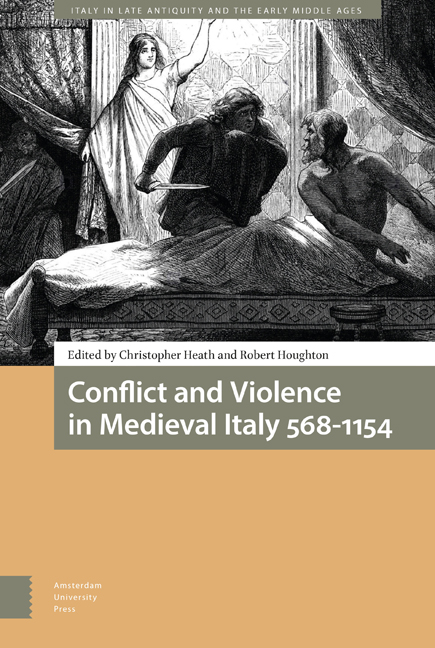Book contents
- Frontmatter
- Table of Contents
- Abbreviations
- Preface
- 1 Introduction: Discordant Minds and Hostile Nations
- 2 Morbidity and Murder: Lombard Kingship’s Violent Uncertainties 568-774
- 3 Insurgency and Counterinsurgency in Lombard Italy (c600-700)
- 4 Troubled Times: Narrating Conquest and Defiance between Charlemagne and Bernard (774-818)
- 5 ‘Nec patiaris populum Domini ab illis divinitus fulminandis Agarenis discerpi’: Handling ‘Saracen’ Violence in Ninth-Century Southern Italy
- 6 Formosus and the ‘Synod of the Corpse’: Tenth Century Rome in History and Memory
- 7 Sex, Denigration and Violence: A Representation of Political Competition between Two Aristocratic Families in Ninth Century Italy
- 8 ‘Italy and her [German] Invaders’: Otto III’s and Frederick Barbarossa’s Early Tours of Italy – Pomp, Generosity and Ferocity
- 9 ‘I Predict a Riot’: What Were the Parmense Rebelling Against in 1037?
- 10 The Strange Case of Deusdedit and Pandulf: Two Accounts of Honorius II’s Election
- Afterword
- Index
5 - ‘Nec patiaris populum Domini ab illis divinitus fulminandis Agarenis discerpi’: Handling ‘Saracen’ Violence in Ninth-Century Southern Italy
Published online by Cambridge University Press: 07 September 2022
- Frontmatter
- Table of Contents
- Abbreviations
- Preface
- 1 Introduction: Discordant Minds and Hostile Nations
- 2 Morbidity and Murder: Lombard Kingship’s Violent Uncertainties 568-774
- 3 Insurgency and Counterinsurgency in Lombard Italy (c600-700)
- 4 Troubled Times: Narrating Conquest and Defiance between Charlemagne and Bernard (774-818)
- 5 ‘Nec patiaris populum Domini ab illis divinitus fulminandis Agarenis discerpi’: Handling ‘Saracen’ Violence in Ninth-Century Southern Italy
- 6 Formosus and the ‘Synod of the Corpse’: Tenth Century Rome in History and Memory
- 7 Sex, Denigration and Violence: A Representation of Political Competition between Two Aristocratic Families in Ninth Century Italy
- 8 ‘Italy and her [German] Invaders’: Otto III’s and Frederick Barbarossa’s Early Tours of Italy – Pomp, Generosity and Ferocity
- 9 ‘I Predict a Riot’: What Were the Parmense Rebelling Against in 1037?
- 10 The Strange Case of Deusdedit and Pandulf: Two Accounts of Honorius II’s Election
- Afterword
- Index
Summary
Abstract
Based on selected Latin sources, this chapter focusses on physical violence between Christians and Muslims in ninth-century southern Italy and analyses its actors, dimensions, circumstances, and consequences. Despite rhetorical exaggerations and the victim's perspective, the sources provide evidence for a decade-long state of armed conflicts, of sustained threats, far-reaching devastation, and significant numbers of victims among the Christian populations. The Muslim presence influenced new dimensions of violence, with consequences for demographic, economic, and political structures in the affected regions. Several factors work together to characterise southern Italy as an ‘area permeated with violence’ (gewaltoffener Raum) and as a border region where several ‘violent communities’ were continuously competing for resources and power, also leaving, however, room for non-violent options.
Keywords: violence, Christian-Muslim relations, southern Italy, border region, papacy, Rome
In varying degrees, violence has always been an option for action and belongs to the inventory of probably all people at all times, be it personally exercised, experienced, observed, or (re)presented in oral narratives, written texts, images, or in the media. Far from being an innate instinct, aggression can be understood as the output of several psychological systems that differ in their environmental triggers, their internal logic, their neurobiological basis, and their social distribution. It is both an individual action and a manifestation of social relationships between different entities. Violence has therefore not only actors. It is also the result of actions or manifests itself in them. As a consequence, and so far, as historical perspectives are concerned, the individual violent act and the social practice of violence as well as its perception have to be seen against the background of specific conditions and dynamics.
Violence research is an important field of scientific debate in many disciplines. However, there is no consensus on what can be called ‘violence’ which prompts conceptual and methodological questions. For example, physical, psychological, structural, symbolic, cultural, political, individual, or collective violence can be distinguished, and in doing so also practices of infliction and suffering. Mainly – and this applies to the medieval disciplines, too – events of physical violence, i.e. activities aimed at deliberately damaging a person's physical integrity, are at the centre of research.
- Type
- Chapter
- Information
- Conflict and Violence in Medieval Italy 568-1154 , pp. 149 - 184Publisher: Amsterdam University PressPrint publication year: 2021



